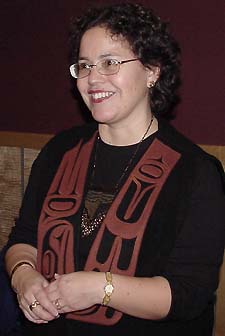 National American Indian Heritage Month Celebrated With Special Programs Story & Photos by Gigi Pilcher November 14, 2002
Ketchikan residents, young and old alike, were treated to a very informative program as well as culinary delights by Dr. Delores (Dolly) Garza, a Professor of the University of Alaska Marine Advisory Program. Gayle Nixon of the Southeast Alaska Discovery Center introduced Professor Garza, and the Professor addressed the crowd in her maternal language of Haida and followed Native tradition by giving homage to her house and clan. Dr. Garza's informative presentation included a slide show of the various food items that are staples in the traditional diet of Southeast Alaska Native peoples and she spoke about the areas throughout Southeast Alaska where the foods could be harvested. Professor Garza said that subsistence gathering begins in the spring and continues through early fall with the food being dried or smoked to last through the winter months. The month of March marks the beginning of subsistence gathering with herring roe on kelp or roe on hemlock branches. She said that areas around Sitka are most plentiful and the harvesters share the roe with others who do not have access to boats or can't go out to gather. Dr. Garza also shared information about:
In July, Garza said that dip netting for sockeye salmon begins and the salmon is dried or smoked. Blueberries, salmon berries and elder berries are also picked and dried to last the winter.
Dr. Garza is Haida and Tlingit. She was born and raised in Southeast Alaska and learned subsistence gathering as a child growing up in Hydaburg and Ketchikan. Garza is author of a national award-winning, two-volume curriculum called "Outdoor Survival Training for Alaska's Youth" which includes a student workbook and teacher manual. She also wrote the booklet "Surviving on the Foods and Waters of Alaska's Southeast Shores." For her work on "Tlingit Moon and Tide Teaching Resource", Professor Garza won the 1999 American Book Award, sponsored by the Before Columbus Foundation.
For more information about Dr. Garza or subsistence gathering:
Upcoming Events:
|
|||

